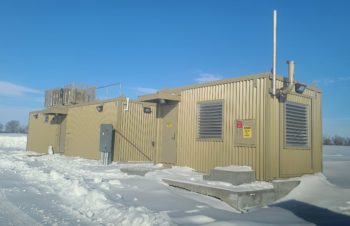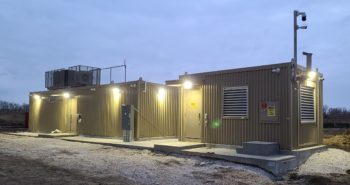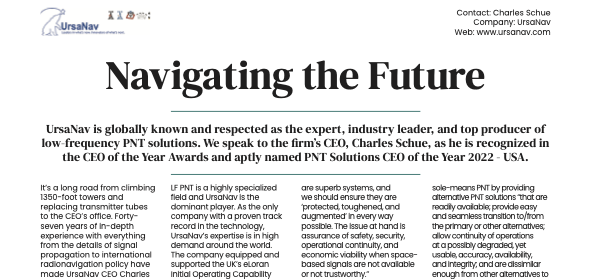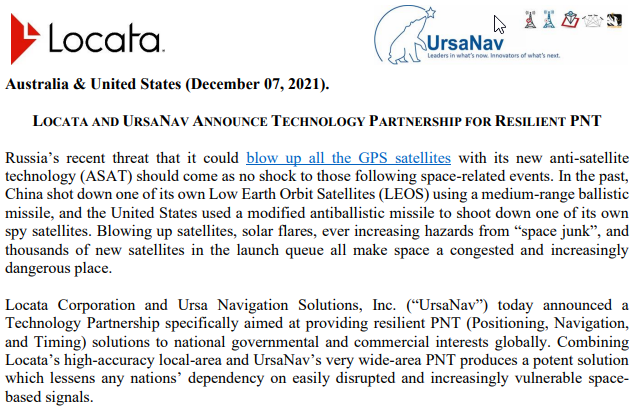
December 2023 – UrsaNav’s CEO, Charles Schue, has accepted a position as co-chair on the CARNATIONS “Technology Transfer” subcommittee at Illinois Tech’s Tier 1 University Transportation Center. UrsaNav’s Chief Business Development Officer, Erik Johannessen adds resilience to the position. The goal of the subcommittee is to maintain a strong connection between industry partners and the CARNATIONS Advisory Board (CAB). The CAB Technology Transfer subcommittee’s mission, which the subcommittee may refine, is to assess CARNATIONS technology transfer progress, track the “Technology Transfer Performance Metrics”, and provide ideas and recommendations in between annual meetings to improve CARNATIONS performance in this area.

December 2023 – UrsaNav has formed an EU subsidiary: UrsaNav EU Limited. UrsaNav’s CEO, Charles Schue, stated, “A collateral effect of the geo-political problems in Europe and the Middle East is the significantly increased instances of GNSS jamming and spoofing. The EU recognizes that a terrestrial backup to GNSS, particularly for timing, offers an improved level of safety and security to its member states. Several European countries have operated Loran stations in the past, including Denmark, France, Germany, Italy, and Spain, and the European Space Agency is exploring Enhanced Loran (eLoran) as part of its resiliency toolkit. Having contributed to the design, development, installation, and support of the former Loran facilities in Europe, we look forward to working with our European colleagues to improve their PNT resilience via implementation of a wide-area, terrestrial backup to GNSS.”

December 2023 – UrsaNav is proud to be a sponsor of the “GPS at 50” celebration being held the evening before the National Space-Based PNT Advisory Board meeting in Houston, Texas. This event is hosted by the Resilient Navigation and Timing Foundation (https://rntfnd.org/), and features an interview between GPS World magazine and Dr. Brad Parkinson, the original architect and advocate of what is now simply referred to as GPS. In recent years, Dr. Parkinson has been the driving force behind “Protect, Toughen, and Augment (PTA)” as a strategy to counter over-dependence on sole-means GPS. UrsaNav strongly supports the concept of PTA and looks forward to another fifty years of GPS.

October 2023 – UrsaNav has formed a UK subsidiary: UrsaNav UK Limited. UrsaNav’s CEO, Charles Schue, stated, “The UK has provided leadership in resilient Positioning, Navigation, and Timing (PNT) for decades and UrsaNav has developed strong partnerships with government, industry, and academia during that time. It was a logical next step for us to create a UK company where we can work hand-in-hand with our colleagues to protect critical national infrastructure, while improving the safety and security of people, businesses, and the economy.”

October 2023 – UrsaNav’s CEO, Charles Schue, will be speaking at the upcoming Association of Federal Communications Consulting Engineers Luncheon Meeting on October 20th. The topic is: “Space-based PNT is great … until it isn’t. Why Loran is here to stay.” For more information, please see: https://afcce.org/october-20th-luncheon-meeting/

September 14, 2023 – UrsaNav is pleased to have been a sponsor at the Royal Institute of Navigation’s Marine Navigation Special Interest Group reception held on board THV Galatea, moored alongside HMS Belfast, during London International Shipping Week. A key theme of the reception was the evolution of navigation for autonomous vessels. THV Galatea has previously conducted sea trials where it was able to continuously operate and perform its mission by using eLoran during periods of intentional GPS jamming by the UK Government. The ability for continuous operations during GNSS jamming and/or spoofing events is crucial for the safety of manned and unmanned (i.e., autonomous) shipping operations. eLoran provides the accuracy, availability, continuity, and integrity required for continuity of operations in the maritime, general aviation, land-mobile, and time and frequency sectors.

July 26, 2023 – UrsaNav accepted an invitation to join the Illinois Institute of Technology’s Tier 1 Transportation Center contract to “Bolster Cybersecurity in Navigation Systems”. UrsaNav will support this effort through attendance on the CARNATIONS Advisory Board (“CAB”), with concentration on Jump Start Projects (JSP) 3 and 4. For more information, please see: https://www.iit.edu/news/illinois-techs-carnations-receives-10m-federal-grant-new-tier-1-transportation-center-bolster or https://www.iitcarnations.org/

June 2023 – UrsaNav is pleased that Babcock International Group has extended our agreement with them to support their Operations and Maintenance (O&M) of the United Kingdom’s eLoran site located at Anthorn, Cumbria, England. UrsaNav has been working with Babcock’s Marine Technology organization since 2009, and provides support for some of the eLoran equipment at the Anthorn site. The Loran technology there was provided by Megapulse, a company that UrsaNav acquired in 2012. This latest order from Babcock provides equipment support through the end of 2024. UrsaNav’s global leadership and continuing advancements in eLoran products and services is why companies like Babcock choose to work with us.

April 2023 – UrsaNav, Inc. headquartered in North Billerica, MA, USA was recently awarded a contract from Jeraisy Computer and Communication Services of Riyadh, Kingdom of Saudi Arabia. The main contract is for a significant recapitalization of parts of the Mawani (formerly Saudi Sea Ports Authority) Loran-C infrastructure.
We are providing equipment and services required to migrate from Loran-C to Enhanced Loran (eLoran). The main activities include migrating from System Area Monitor (SAM) control to Time-of-Transmission TOT) control, improving the accuracies in select ports with Differential Reference technology, adding a UTC timing service, adding a second data channel, and integrity monitoring of the four major GNSS.
Existing high-power transmitters will be upgraded with new timing synchronization, monitor, and control equipment. Differential Reference station equipment will be deployed at five ports. Existing SAM sites will be re-purposed with eLoran and GNSS monitoring equipment. Also included is new hardware and software for management and control of the system, upgrades to a depot test transmitter, associated spare parts, and a complement of user equipment.
This contract in the Kingdom of Saudi Arabia follows the recent completion of an eLoran transmitter site in the Republic of Korea. Chuck Schue, CEO of UrsaNav, remarked “We are very proud to have the opportunity to continue our decades long relationship with Mawani. They clearly understand the need for resilience and the potential consequences from over-dependence on GNSS”.

March 2023 – The founder of nine businesses ranging from providing key components of ion plasma rocket engines to making the world’s best crispy beef jerky, Schue is the quintessential entrepreneur. His roots are firmly in radionavigation, though. The most recent evidence of this was his recognition as PNT Solutions CEO of the Year 2022 – USA at the CEO of the Year Awards. A very well-deserved and fitting accolade indeed!
See the full article at https://www.ceo-review.com/issues/issue-3-2023/9/

January 2022 – UrsaNav’s CEO, Charles Schue, was elected to the Fellow Grade of the Institute of Navigation (“FION”). At a ceremony held at the ION’s ITM/PTTI conference in Long Beach, CA, Mr. Schue was cited “For distinguished and sustained technical and strategic contributions, leadership, and guidance in resilient PNT solutions.” Ten years ago, in May of 2012, Mr. Schue was elected as a Fellow of the Royal Institute of Navigation (“FRIN”) “In recognition of his outstanding contributions to navigation, notably in respect of low frequency terrestrial systems.” It is rare that someone achieves Fellow status in both Institutes of Navigation, and Mr. Schue is honored and humbled to be recognized alongside his peers on both sides of the Atlantic.
Read more: https://www.linkedin.com/pulse/charles-schue-iii-elected-institute-navigation-2022-fellow-schue

Australia & United States (December 07, 2021)
LOCATA AND URSANAV ANNOUNCE TECHNOLOGY PARTNERSHIP FOR RESILIENT PNT
Russia’s recent threat that it could blow up all the GPS satellites with its new anti-satellite technology (ASAT) should come as no shock to those following space-related events. In the past, China shot down one of its own Low Earth Orbit Satellites (LEOS) using a medium-range ballistic missile, and the United States used a modified antiballistic missile to shoot down one of its own spy satellites. Blowing up satellites, solar flares, ever increasing hazards from “space junk”, and thousands of new satellites in the launch queue all make space a congested and increasingly dangerous place.
Locata Corporation and Ursa Navigation Solutions, Inc. (“UrsaNav”) today announced a Technology Partnership specifically aimed at providing resilient PNT (Positioning, Navigation, and Timing) solutions to national governmental and commercial interests globally. Combining Locata’s high-accuracy local-area and UrsaNav’s very wide-area PNT produces a potent solution which lessens any nations’ dependency on easily disrupted and increasingly vulnerable space- based signals.
Read Full Press Release:

November 2021 – There is a lot of coverage of (e)Loran in the latest NIST Technical Notes #2187 and 2189, available at these links: https://doi.org/10.6028/NIST.TN.2187 and https://doi.org/10.6028/NIST.TN.2189. Full disclosure, although NIST did not reach out to UrsaNav to provide direct input/comment to their publications (not unusual), they used a lot of UrsaNav text, graphics, and pix in their discussions of Loran and eLoran. These documents are an incredibly rich source of timing information for the public and private sectors. NIST (and USNO) has always been a fan of eLoran, and Loran-C before it, so we were glad to see they still consider it a valuable alternative to GNSS. As you may recall, Loran-C was a DOD system so its timing was “sourced” from the USNO (via “hot clocks”) and the USNO monitored its relationship to UTC and provided notices to users of any offset(s) and drift rates. This is similar to the function that the USNO provides for GPS.
Note that NIST did not mention that (e)Loran can operate in a Two-Way Low-Frequency Time Transfer (TWLFTT) mode. TWLFTT can provide a terrestrial, layered time-transfer network wherein time is transferred between any two (e)Loran transmission sites that can receive each other’s signals. UrsaNav tested this theory as part of our first CRADA with the USCG Research and Development Center, which started in 2012. Note that TWLFTT is completely “sky-free”.
Note also that there has been a lot of “hay” made from (e)Loran competitors that there are no miniature LF receivers. This is simply not true. Even at the 60kHz signal that WWV uses (40 kHz lower than Loran), timing receivers are easily chip-scale. See page 148 of NIST 2187. Further miniaturization is not an issue of science or technology; it’s simply a matter or market demand.
There were a couple of statements in NIST 2187 that we found extremely troubling, and which we are bringing to the attention of the authors:
“Beginning in the early 1990s, the Loran-C stations were synchronized with GPSDCs, with the Hewlett-Packard GPS Smart Clock used as the primary reference at many station sites after about 1997. This direct synchronization to GPS did, of course, invalidate the premise that Loran-C, and the proposed eLoran system that followed, were GNSS independent, which made them unsuitable as a GPS backup system.”
GPS was not fully operational until 1995. GPSDCs were NOT used operationally at any North American Loran-C stations, and at no other international Loran-C stations of which we are aware before 1999. The USCG did test various methods of distributing UTC to the Loran stations, including TWSTT and GPS Common Mode, starting around 1993, but these tests were never moved into full operation. The USCG started installing Time-of-Transmission Monitors (TTM) at the transmission sites in the late 1990’s and early 2000’s. The initial installations were at only at few test sites, and then only at the Master transmission stations. It was not until later that the TTMs were installed at all Loran-C stations in North America as part of the redesign of the Frequency Standard Rack. The TTM included a GPS disciplined quartz oscillator, but the system was not directly connected to the station timing generation equipment, and was not used to control the transmissions. The TTM only reported the difference between the transmission times and UTC, as referenced against a local, survey-grade GPS Timing Receiver. It is not correct to suggest that these GPS Smart Clocks were used as “the primary reference”; they were an external reference against which the three Primary Reference Standards at the transmission sites were compared, originally manually and then via software. The primary reference for generating the timing of Loran transmissions has always been the three rubidium or cesium standards.
Starting in 2003, the first version of the Timing and Frequency Equipment (TFE) was installed at North American Loran-C stations as part of the Loran Modernization and Upgrade Program. Although not intended, this first version did not provide sufficient separation between GPS and the transmitted Loran signal. The software allowed the transmission sites to be steered without bound using GPS as an input. This software error was subsequently corrected in later versions of the TFE.
A well-designed eLoran system would have no direct connection to any external timing source, whether it be GNSS, TWTT, microwave, or fiber. All of these sources might be monitored, but there would be an air-gap between them and the triple ensemble of Primary Reference Standards. The system would be purpose-built to not allow an external timing reference to be able to “walk” the station’s timing away from UTC, and the system could operate for a defined period without an external reference of any sort. The fact that a modern eLoran transmission site might use GPS or another GNSS as external references is not the same as saying they are directly synchronized to them.

November 2021 – UrsaNav and its CEO, Charles Schue, are cited several times in the GPS World article entitled: “eLoran: Part of the solution to GNSS vulnerability”. UrsaNav has always considered eLoran a key component of a service provider’s “Resilience Triad” that delivers Resilient PNT (RPNT), and also a major component of any PNT System-of-Systems. Another necessary component is GNSS. It is time to consider that a triad might not best represent the RPNT model of the future. Certainly, two very important components are eLoran and GNSS, but other solutions include fiber, a Metro Beacon System (MBS, e.g., Locata), and even 5G or R-Mode (VHF). From a user’s perspective, their PNT “sensor ensemble” should include GNSS and eLoran for wide area coverage, an MBS for local area coverage, and a good on-board clock for timing applications or inertial navigation system for positioning. Fiber is a great option for point-to-point solutions that do not require wireless capabilities. See: https://www.gpsworld.com/eloran-part-of-the-solution-to-gnss-vulnerability/

July 2021 – A collaboration of the Oscilloquartz (an ADVA company) grandmaster clock and our own eLoran receiver technologies yields a robust and reliable backup for GPS and other GNSS, and could be used to provide an assured position, navigation, and timing (PNT) service. Harnessing ADVA’s flexible OSA 5420 Series, designed with assured PNT (aPNT) technology, UrsaNav has shown that eLoran can provide a new layer of protection and significantly boost timing resilience and security. See: https://www.businesswire.com/

July 2021 – UrsaNav’s CEO, Charles Schue, was cited in the First Fix segment of the July issue of GPS World where he stated that “the only replacement for a GNSS is another GNSS” and for his definition of alternative PNT: “An alternative PNT solution is one that is readily available; provides an easy and seamless transition to/from the primary or other alternatives; allows continuity of operation at a possibly degraded, yet usable, accuracy, availability, integrity, or continuity; and is dissimilar enough from other alternatives to withstand the effects that might be affecting the primary solution.” He also contributed to the Alternative PNT Q&A article.
See: https://editions.mydigitalpublication.com/

April 2021 – UrsaNav continues to deliver exceptional products and services, even during the dreadful global Pandemic. As an example of how things can go with a committed customer, we are completing a High-Power RF transmitting station site project that was started the summer before the COVID Pandemic. This high-power radio station is located in difficult terrain and includes very complex construction, technology, and security elements. As the pictures below can attest, our management of the project has kept things moving even in incredibly difficult times. We are working with almost 50 vendors, partners, and government organizations and are close to making the site operational. Our customer has been 100% involved, committed, and supportive from starting the project through helping ensure its success. Together, we have overcome all of the travel and supply chain issues that have plagued projects since COVID impacts began back in November 2019. We have carefully followed all CDC guidelines and successfully balanced the needs of our customers, vendors, and partners, with those of our staff. I am confident that, working with you, we can perform similarly for all of your PNT service delivery or user experience needs.



April 2021 – UrsaNav is pleased to announce its continued support of the South Korean Ministry of Oceans and Fisheries (MOF) in their deployment of a terrestrial eLoran PNT system to complement and back up GPS/GNSS. UrsaNav was the key technology provider to the South Korean Government for their eLoran IOC system, and we look forward to supporting MOF as they expand their eLoran system to cover all of their sovereign territory and maritime exclusive economic zone. South Korea is a first mover in the provision of a comprehensive system-of-systems approach to PNT services that protect their critical national infrastructure and their citizens. Please see Terrestrial navigation system ready for use in S. Korea to cope with jamming and electric warfare (ajudaily.com) for additional information.

March 2021 – The US Patent and Trademark Office (USPTO) has approved UrsaNav’s Private eLoran patent (United States Patent Application 20190377055). Private eLoran is a new and innovative breakthrough in terrestrial PNT technology that provides secure, un-spoofable, and virtually un-jammable PNT signals. Private eLoran provides a secure co-primary alternative, or complementary backup, to GPS/GNSS for individual nation-states or collaborative regions. Private eLoran significantly reduces the risk/reward equation for those who wish to jam or spoof PNT signals, especially those that are space-based. With this new capability, service providers can now deliver fully-open or fully closed solutions, or a combination of both. This new patented technology is another leap forward in UrsaNav’s progressively innovative eLoran and LFPhoenix™ products and services.

March 2021 – UrsaNav’s CEO, Charles Schue, and Board of Advisors Member, Dr. Wouter Pelgrum, have the pleasure of announcing that the long awaited Two-Volume Set entitled “Position, Navigation, and Timing Technologies in the 21st Century, Volumes 1 and 2: Integrated Satellite Navigation, Sensor Systems, and Civil Applications, Set 1st Edition” is now available. Chapter 41 provides historical and current information on “Navigation with Low-Frequency Radio Systems”, and also provides a peek into what may be coming in the future. Given the authorship of this chapter, it naturally includes a comprehensive study of Loran-C and Enhanced Loran systems. We are extremely honored to have been selected to participate in this incredibly important and comprehensive project that showcases all the various technologies necessary for a resilient PNT ecosystem. The work is available from Wiley (https://www.wiley.com/en-us/exportProduct/pdf/9781119458340) and other fine outlets.

March 2021 – UrsaNav comments on the recently released “Complementary PNT and GPS Backup Technologies Demonstration Report – DOT Report Number DOT-VNTSC-20-07 dated January 2021.”

In June 2020, UrsaNav completed delivery of an eLoran Transmission system at a temporary location near Incheon, ROK.
For additional information: https://www.gpsworld.com/ursanav-installs-eloran-testbed-in-south-korea/

Find us at the International Defence Exhibition & Conference (IDEX), Abu Dhabi, UAE – February 17-21, 2019.

In collaboration with the General Lighthouse Authorities of the UK and Ireland (GLA), UrsaNav provided an article for the Royal Institute of Navigation’s Navigation News Magazine entitled: “The Resilience Series: Ground-Based Navigation Systems”. Please read the excerpted article here and be sure to sign in to read it on the RIN’s website: www.rin.org.uk.

Find us at the ION International Technical Meeting (ITM) / Precise Time and Time Interval (PTTI) Conference in Reston, VA – January 28-31, 2019.

Charles Schue appointed to the Institute of Navigation (ION) Council – January 28, 2019.

Charles Schue co-authored the Low Frequency Radio Navigation chapter of the Position, Navigation, and Timing Technologies in the 21st Century: Integrated Satellite Navigation, Sensor Systems, and Civil Applications book edited by Jade Morton, Frank van Diggelen, James Spilker, Bradford Parkinson, with associate editors Sherman Lo and Grace Gao. The book was recently announced on Wiley Publications’ website.

ROK eLoran Contract Award – The Korea Research Institute of Ships and Oceans Engineering (KRISO) has awarded UrsaNav, through its agent, Dong Kang M-Tech, a contract to supply an eLoran Transmitter Test Bed System in the Republic of Korea. Read More

UrsaNav is pleased to be working with Spectracom on the development of this exciting new timing product. It demonstrates the market’s demand and the importance companies have started to place on resilient timing solutions for critical operations and infrastructure. Read More


